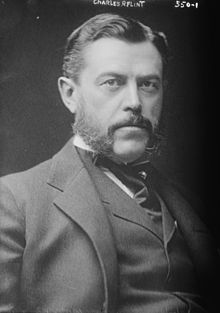Charles Ranlett Flint
| Charles Ranlett Flint | |
|---|---|

Flint in 1907
|
|
| CEO of Computing-Tabulating-Recording Company | |
|
In office 1911–1914 |
|
| Succeeded by |
Thomas J. Watson as CEO of IBM |
| Personal details | |
| Born |
January 24, 1850 Thomaston, Maine, U.S. |
| Died | February 26, 1934 (aged 84) Washington, D.C., U.S. |
| Spouse(s) |
|
| Occupation | Financial capitalist |
Charles Ranlett Flint (January 24, 1850 – February 26, 1934) was an American and was the founder of the Computing-Tabulating-Recording Company which later became IBM. For his financial dealings he earned the moniker "Father of Trusts".
Flint was born on January 24, 1850 in Thomaston, Maine. His father, Benjamin Chapman, had changed the family name to Flint after being adopted by an uncle on his mother's side. The family moved from Maine to New York City where his father ran the family's mercantile firm Chapman & Flint, which had been founded in 1837.
In 1868, Charles Flint graduated from the New York University - Tandon School of Engineering (then Polytechnic University of New York) in Brooklyn, and in 1871 entered the shipping business as a partner in Gilchrest, Flint & Co., and later W.R. Grace & Co. after a merger.
From 1876 to 1879, he served as the Chilean consul at New York City. He also served as consul general to the United States for Nicaragua and Costa Rica.
In 1892, he consolidated several companies to form U.S. Rubber. In 1899 he repeated the same with Adams Chewing Gum, Chiclets, Dentyne, and Beemans to form American Chicle. He was also responsible for the formation of American Woolen in 1899.
In 1911 he formed the Computing-Tabulating-Recording Company through the amalgamation (via stock acquisition) of four companies: The Tabulating Machine Company, International Time Recording Company, Computing Scale Company of America, and the Bundy Manufacturing Company.Amalgamation was unusual at the time, Flint described it as an "allied" consolidation. In 1924, CTR was re-christened as International Business Machines. Flint served on the board of directors of IBM until 1930 when he retired.
...
Wikipedia
